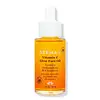What's inside
What's inside
 Key Ingredients
Key Ingredients

 Benefits
Benefits

 Concerns
Concerns

 Ingredients Side-by-side
Ingredients Side-by-side

Caprylic/Capric Triglyceride
MaskingHelianthus Annuus Seed Oil
EmollientNeopentyl Glycol Diethylhexanoate
EmollientTetrahexyldecyl Ascorbate
AntioxidantSimmondsia Chinensis Seed Oil
EmollientRubus Idaeus Seed Oil
EmollientVaccinium Macrocarpon Seed Oil
Skin ConditioningHippophae Rhamnoides Seed Oil
Skin ProtectingCurcuma Longa Root Oil
PerfumingZingiber Officinale Root Oil
MaskingTocopheryl Acetate
AntioxidantMica
Cosmetic ColorantTitanium Dioxide
Cosmetic ColorantIron Oxides
Parfum
MaskingCaprylic/Capric Triglyceride, Helianthus Annuus Seed Oil, Neopentyl Glycol Diethylhexanoate, Tetrahexyldecyl Ascorbate, Simmondsia Chinensis Seed Oil, Rubus Idaeus Seed Oil, Vaccinium Macrocarpon Seed Oil, Hippophae Rhamnoides Seed Oil, Curcuma Longa Root Oil, Zingiber Officinale Root Oil, Tocopheryl Acetate, Mica, Titanium Dioxide, Iron Oxides, Parfum
Water
Skin ConditioningPropanediol
SolventPPG-24-Glycereth-24
EmulsifyingGlycerin
Humectant3-O-Ethyl Ascorbic Acid
Skin ConditioningTroxerutin
Skin ConditioningCistus Incanus Flower/Leaf/Stem Extract
Skin ConditioningNonapeptide-1
Skin ConditioningPolygonum Aviculare Extract
EmollientTerminalia Ferdinandiana Fruit Extract
AntioxidantPEG-40 Hydrogenated Castor Oil
EmulsifyingSodium Polyacryloyldimethyl Taurate
Emulsion StabilisingPPG-26-Buteth-26
Skin ConditioningMaltodextrin
AbsorbentCaprylyl Glycol
EmollientPotassium Sorbate
PreservativeSodium Phosphate
BufferingSodium Benzoate
Masking1,2-Hexanediol
Skin ConditioningTetrasodium EDTA
Disodium Phosphate
BufferingCitric Acid
BufferingCaprylhydroxamic Acid
Parfum
MaskingLimonene
PerfumingLinalool
PerfumingCitral
PerfumingCI 15985
Cosmetic ColorantWater, Propanediol, PPG-24-Glycereth-24, Glycerin, 3-O-Ethyl Ascorbic Acid, Troxerutin, Cistus Incanus Flower/Leaf/Stem Extract, Nonapeptide-1, Polygonum Aviculare Extract, Terminalia Ferdinandiana Fruit Extract, PEG-40 Hydrogenated Castor Oil, Sodium Polyacryloyldimethyl Taurate, PPG-26-Buteth-26, Maltodextrin, Caprylyl Glycol, Potassium Sorbate, Sodium Phosphate, Sodium Benzoate, 1,2-Hexanediol, Tetrasodium EDTA, Disodium Phosphate, Citric Acid, Caprylhydroxamic Acid, Parfum, Limonene, Linalool, Citral, CI 15985
Ingredients Explained
These ingredients are found in both products.
Ingredients higher up in an ingredient list are typically present in a larger amount.
Parfum is a catch-all term for an ingredient or more that is used to give a scent to products.
Also called "fragrance", this ingredient can be a blend of hundreds of chemicals or plant oils. This means every product with "fragrance" or "parfum" in the ingredients list is a different mixture.
For instance, Habanolide is a proprietary trade name for a specific aroma chemical. When used as a fragrance ingredient in cosmetics, most aroma chemicals fall under the broad labeling category of “FRAGRANCE” or “PARFUM” according to EU and US regulations.
The term 'parfum' or 'fragrance' is not regulated in many countries. In many cases, it is up to the brand to define this term.
For instance, many brands choose to label themselves as "fragrance-free" because they are not using synthetic fragrances. However, their products may still contain ingredients such as essential oils that are considered a fragrance by INCI standards.
One example is Calendula flower extract. Calendula is an essential oil that still imparts a scent or 'fragrance'.
Depending on the blend, the ingredients in the mixture can cause allergies and sensitivities on the skin. Some ingredients that are known EU allergens include linalool and citronellol.
Parfum can also be used to mask or cover an unpleasant scent.
The bottom line is: not all fragrances/parfum/ingredients are created equally. If you are worried about fragrances, we recommend taking a closer look at an ingredient. And of course, we always recommend speaking with a professional.
Learn more about Parfum